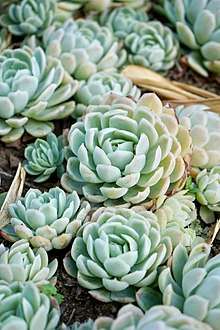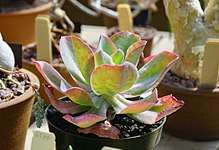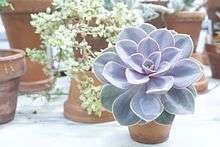Echeveria
| Echeveria | |
|---|---|
 | |
| Echeveria elegans | |
| Scientific classification | |
| Kingdom: | Plantae |
| Clade: | Angiosperms |
| Clade: | Eudicots |
| Order: | Saxifragales |
| Family: | Crassulaceae |
| Subtribe: | Sedinae |
| Genus: | Echeveria DC.[1] |
| Species | |
|
See text. | |
| Synonyms | |
|
Courantia Lem. | |
Echeveria is a large genus of flowering plants in the stonecrop family Crassulaceae, native to semi-desert areas of Central America, Mexico and northwestern South America.
Description
Plants may be evergreen or deciduous. Flowers on short stalks (cymes) arise from compact rosettes of succulent fleshy, often brightly coloured leaves.[2] Species are polycarpic, meaning that they may flower and set seed many times over the course of their lifetimes. Often numerous offsets are produced, and are commonly known as "hen and chicks", which can also refer to other genera, such as Sempervivum, that are significantly different from Echeveria. Many species of Echeveria serve important environmental roles, such as those of host plants for butterflies. For example, the butterfly Callophrys xami uses several species of Echeveria, such as Echevelia gibbiflora, for suitable host plants. Even more, these plants are integral to the oviposition process of C. xami and some other butterfly species as well.[3][4]
Taxonomy
The genus was erected by A. P. de Candolle in 1828, and is named after the 18th century Mexican botanical artist Atanasio Echeverría y Godoy. As of June 2018, the genus consists of about 150 species, including genera such as Oliveranthus and Urbinia that have formerly been split off from Echeveria. Molecular phylogenetic studies have repeatedly shown the genus not to be monophyletic: species of Echeveria cluster with species of Cremnophila, Graptopetalum, Pachyphytum, and Thompsonella as well as species of Sedum sect. Pachysedum. The former Urbinia species do appear to form a monophyletic group within this grouping.[5][6] Although it is clear that Echeveria is not monophyletic, its limits are not clear, and further analyses are needed to determine whether and how the genus should be split.[6]
Species
One source accepts the following species:[7]
|
Echeveria acutifolia Lindley |
Echeveria halbingeri Walther |
Echeveria prunina Kimnach & Moran |
Cultivation
Many Echeveria species are popular as ornamental garden plants. They are drought-resistant, although they do better with regular deep watering and fertilizing. Most will tolerate shade and some frost, although hybrids tend to be less tolerant. Most lose their lower leaves in winter; as a result, after a few years, the plants lose their compact appearance and need to be re-rooted or propagated. In addition, if not removed, the shed leaves may decay, harboring fungus that can then infect the plant.

Propagation
They can be propagated easily by separating offsets, but also by leaf cuttings, and by seed if they are not hybrids.
Cultivars and Hybrids
Echeveria has been extensively bred and hybridized. The following is a selection of available plants.
- ‘Arlie Wright’
- ‘Black Prince’
- ‘Blue Heron’
- ‘Blue Surprise’ (E. × gilva)
- ‘Dondo’
- ‘Doris Taylor’
- ‘Ebony’ (E. agavoides cultivar)
- ‘Frank Reinelt’
- ‘Hoveyi’
- ‘Lipstick’ (E. agavoides cultivar)
- ‘Oliver’ (E. pulvinata cultivar)
- ‘Opalina’
- ‘Painted Lady’
- ‘Perle von Nürnberg’
- ‘Paul Bunyan’
- ‘Red’ (E. × gilva)
- ‘Ruberia’
- ‘Set-Oliver’
- ‘Tippy’
- ‘Victor Reiter’ (E. agavoides cultivar)
- ‘Wavy Curls’
- ‘Worfield Wonder’ (E. × derosa)
Award winning

The following have gained the Royal Horticultural Society’s Award of Garden Merit:-[8]
Formerly in Echeveria
- Dudleya anthonyi (as E. anthonyi)
- Dudleya arizonica Rose (as E. arizonica (Rose) Kearney & Peebles)
- Dudleya attenuata (as E. attenuata and E. edulis var. attenuata)
- Dudleya caespitosa (as E. californica, E. cotyledon, E. helleri, and E. laxa)
- Dudleya candida (as E. candida)
- Dudleya cultrata (as E. cultrata)
- Dudleya cymosa (Lem.) Britton & Rose (as E. cymosa Lem.)
- Dudleya edulis (as E. edulis)
- Dudleya pulverulenta ssp. pulverulenta (as E. argentea and E. pulverulenta)
- Dudleya saxosa ssp. collomiae (as E. collomiae)
- Graptopetalum paraguayense (N.E.Br.) E.Walther (as E. weinbergii hort. ex T.B.Sheph.)
- Pachyveria clavifolia (as E. clavifolia)
Photo gallery
 Flowers of Echeveria ‘Blue Curl’
Flowers of Echeveria ‘Blue Curl’ Echeveria cv. ‘Black Prince’
Echeveria cv. ‘Black Prince’ The flowers of E. pulvinata are in bright yellowish orange color.
The flowers of E. pulvinata are in bright yellowish orange color.- E. secunda var. glauca in the UBC Botanical Garden
References
- 1 2 "Genus: Echeveria DC". Germplasm Resources Information Network. United States Department of Agriculture. 2003-06-13. Retrieved 2011-10-21.
- ↑ RHS A-Z encyclopedia of garden plants. United Kingdom: Dorling Kindersley. 2008. p. 1136. ISBN 1405332964.
- ↑ Opler, Paul A. (1999). A Field Guide to Western Butterflies. Houghton Mifflin Harcourt. pp. 218–219. ISBN 0395791510.
- ↑ Ziegler, J. Benjamin; Escalante, Tarsicio (1964). "Observations on the Life History of Callophrys Xami (Lycaenidae)" (PDF). Journal of the Lepidopterists' Society. 18 (2): 85–89.
- ↑ Carrillo-Reyes, Pablo; Sosa, Victoria & Mort, Mark E. (2009), "Molecular phylogeny of the Acre clade (Crassulaceae): Dealing with the lack of definitions for Echeveria and Sedum", Molecular Phylogenetics and Evolution, 53 (1): 267–276, doi:10.1016/j.ympev.2009.05.022
- 1 2 Vázquez-Cotero, Carlos; Sosa, Victoria & Carrillo-Reyes, Pablo (2017), Phylogenetic position of Echeveria heterosepala (Crassulaceae): a rare species with diagnostic characters of Pachyphytum, 95 (3), pp. 515–526, doi:10.17129/botsci.1190
- ↑ http://www.crassulaceae.ch/de/artikel?akID=48
- ↑ "AGM Plants - Ornamental" (PDF). Royal Horticultural Society. July 2017. p. 34. Retrieved 14 February 2018.
- ↑ "RHS Plantfinder - Echeveria agavoides". Retrieved 14 February 2018.
- ↑ "RHS Plantfinder - Echeveria chihuahuaensis". Retrieved 14 February 2018.
- ↑ "RHS Plantfinder - Echeveria derrenbergii". Retrieved 14 February 2018.
- ↑ "RHS Plantfinder - Echeveria elegans". Retrieved 14 February 2018.
- ↑ "RHS Plantfinder - Echeveria 'Perle von Nürnberg'". Retrieved 14 February 2018.
- ↑ "RHS Plantfinder - Echeveria runyonii 'Topsy Turvy'". Retrieved 14 February 2018.
- ↑ "RHS Plantfinder - Echeveria secunda var. glauca 'Compton Carousel'". Retrieved 14 February 2018.
- ↑ "RHS Plantfinder - Echeveria setosa". Retrieved 14 February 2018.
- ↑ "RHS Plantfinder - Echeveria × bombycina". Retrieved 14 February 2018.
External links
| Wikimedia Commons has media related to Echeveria. |
| Wikispecies has information related to Echeveria |